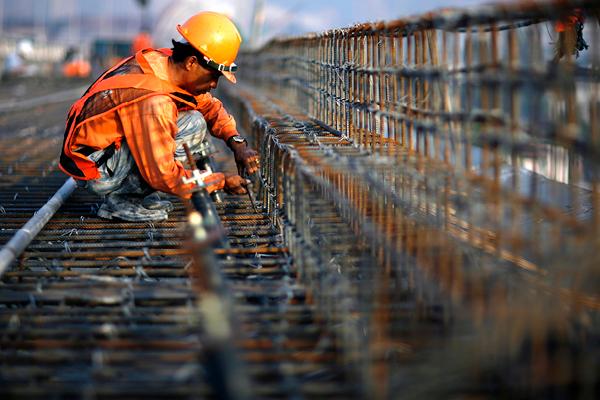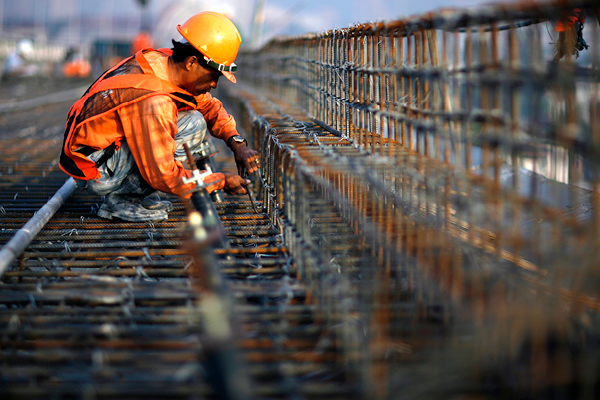
For years now, the Philippines has been one of the fastest-growing economies in Southeast Asia. But the growth has been spotty, with some areas benefitting enormously while others, most notably infrastructure, have remained behind.
Over the next six years, however, the country wants to reverse the trend, with plans to spend around $170 billion in infrastructure, not counting the growing number of public-private partnership (PPP) projects.
Almost $19 billion could be spent next year alone, after the Department for Budget and Management (DBM) set aside the funds in August. The projected spending represents an increase of 11.6 percent over this year and would account for 5.4 percent of GDP.
Just as significantly, the government has approved 16 projects worth $9.19 billion just since September. “Some significant drivers for such high levels of investment are the perceived bankability of the projects and the positive perception of the country’s infrastructure and PPP programs, [as well as] the priority given by the government to infrastructure development and the continuously growing Philippine economy,” says Julius Cervantes, a partner at Philippine law firm Quisumbing Torres, whose main area of focus is foreign investment. “The Philippines, after all, posted a 7.1 percent growth in the past quarter – the strongest growth in Asia,” he adds.
The ramping up of investment in infrastructure since President Rodrigo Duterte took office follows on a similar focus by former President Benigno Aquino before he left office in June. Aquino’s administration had asked for bids on some 50 projects worth a combined total of $6.5 billion. Eleven projects added up to a third of the total, and they included highway construction and land reclamation.
Between 2010 and 2016, Aquino got the ball rolling on 12 projects worth $4.2 billion. “Certainly, the government is trying to generate more interesting in infrastructure, particularly transportation,” observes Franchette M. Acosta, a senior partner at the Manila firm of Villaraza & Angangco (V&A Law). “It is really because of need. There is a need for these infrastructure investments.”
The government has also put in place the Project Development and Monitoring Facility (PDMF) to pave the way for PPP projects. The World Bank, in a recent report, gave the PPP project in the country high marks.
“The current administration has made it very clear that it intends to address the country’s infrastructure requirements by accelerating annual infrastructure spending to account for 5 percent of GDP, with PPPs playing a crucial role,” says Cervantes.
To that end, the government has put forward a series of legislative and regulatory changes that include the National Economic Development Authority’s approval of the Investment Coordination Committee (ICC) Guidelines to process projects involving China; supplemental listing and disclosure rules for partners in PPP infrastructure projects that facilitate access to capital markets; and amendments to the Contractor’s License Law that allows foreign companies to get a license if they have a capitalisation of more than P1 billion (around $21 million). The license makes it possible for contractors to participate in vertical projects worth P5 billion ($104 million) or horizontal projects worth P3 billion ($62.5 million).
At the same time, various government agencies are finalising new guidelines for unsolicited proposals, while the PPP Center is developing a new Foreign Investment Framework for PPP Projects to attract more investors.
LINING UP
With all these initiatives, investors are already showing interest. During a recent visit to China, President Duterte brought back commitments worth $24 billion for funding and investment, including $9 billion in soft loans and a $3 billion line of credit from Bank of China.
Among the deals is a $2.5 billion project between China Railway Engineering Corp and MVP Global Infrastructure Group, as well as a $780 million coastline and port deal in Davao and a 2,000 km railway system in Mindanao. The Philippines also has plans to tap the Asian Infrastructure Investment Bank (AIIB). “China and Japan are set to be big players, considering that the current administration is exerting great effort to further strengthen ties with both countries,” explains Cervantes. Spain, South Korea, Australia, France and the U.S, are all big investors.
Despite impressive economic growth, the need for infrastructure investment in the Philippines is huge. The Asian Development Bank (ADB) estimates that demand will top $730 billion per year for the next decade across Asia, which adds up to $2.5 trillion in Southeast Asia alone.
Weak infrastructure has been a stumbling block to boosting investment in broader terms, which in 2014 added up to 21.8 percent of GDP, well below the regional average, according to the IMF. Infrastructure spending added up to 3 percent of GDP in 2014, and the government had plans to boost that to 5 percent by this year while making it easier to implement PPP projects.
The market for infrastructure construction in the Philippines was worth $12.4 billion in 2015, notes the Infrastructure Intelligence Centre, up from $7.8 billion in 2010, and it could hit $23.9 billion by 2020. International Monetary Fund (IMF) simulations suggest that improving public infrastructure would go a long way to boosting economic output.
Increasing public spending by 2 percent of GDP could boost real GDP by between 9 and 11 percent. “I expect a healthy balance between foreign and domestic investments,” notes Cervantes. “Involvement in infrastructure projects is rising steadily among local conglomerates, and interest also remains strong among foreign players.”
He continues: “A number of large infrastructure companies have opened offices in the Philippines specifically for the purpose of seeking out and participating in local infrastructure projects, whether by themselves or in cooperation with local partners.”
RISKS AND CHALLENGES
The Philippines, however, faces challenges that are just as significant as its needs. Investors have long shied away from the country due to concerns over corruption and business risks.
One area of concern for Cervantes is nationality restrictions, because the Philippines limits foreign participation in some areas, like utilities (foreign ownership is limited to 40 percent). When it comes to public works or defence-related projects, foreign ownership is limited to 25 percent.
Some professions are also restricted. On a more positive note, the current government has suggested that it plans to review the country’s negative list for investment to relax some restrictions on foreign investment.
Another consideration is that participating in an infrastructure project constitutes doing business and a license may be required, along with various capitalisation and tax requirements.
A third important consideration is special licensing requirements for activities such as construction – licenses that are subject to strict conditions. The upshot is that the time might be right to start focusing on this area, says Acosta.
“Always, when you are going to invest, you need to be driving the investment and you need to work with a group of advisors that are attuned to what is going on,” she stresses. And what is going on is that the government is trying to push more projects and attract more investors.
“It’s timely and it’s needed. And when it is timely and it is needed, it is a good time to talk to the government about it."
